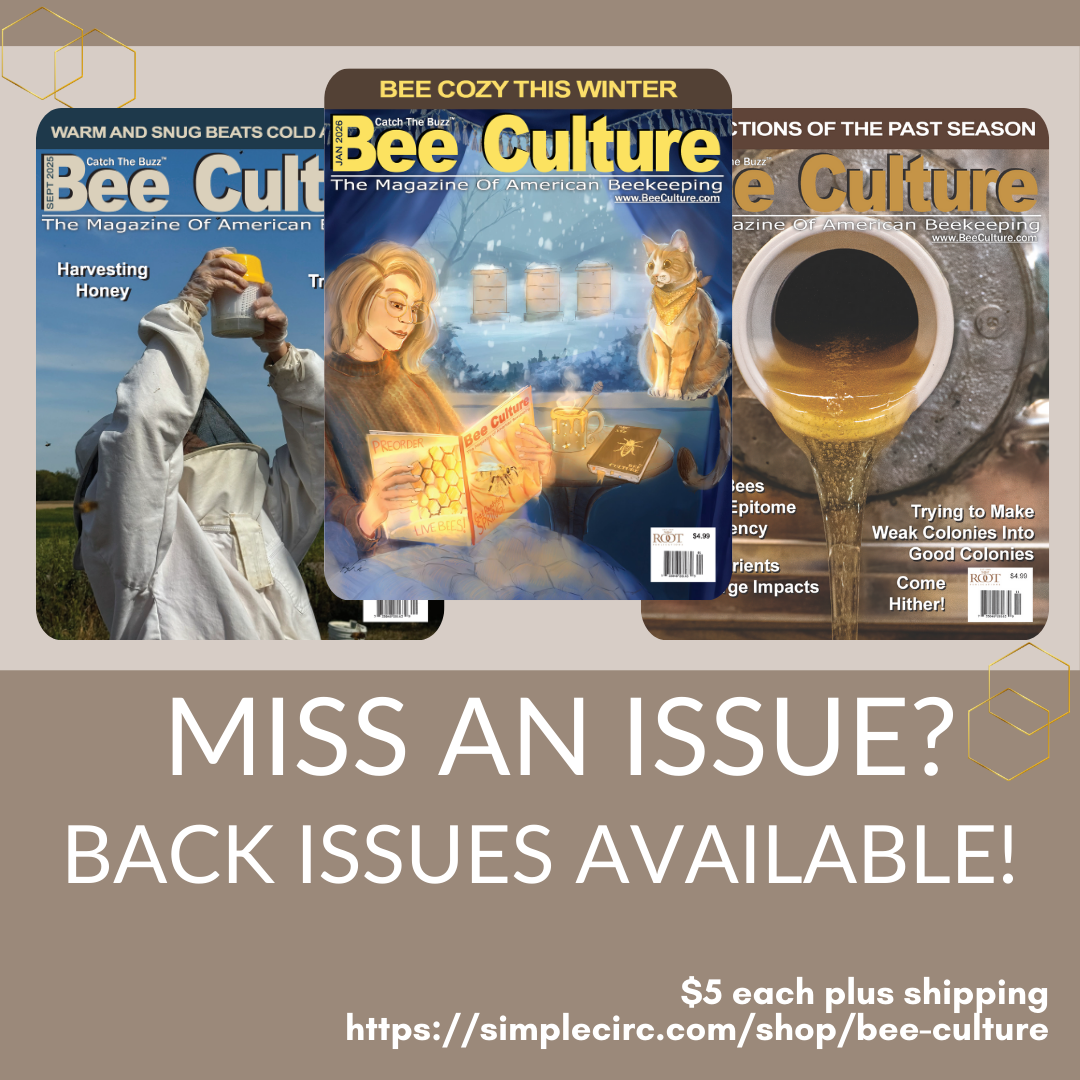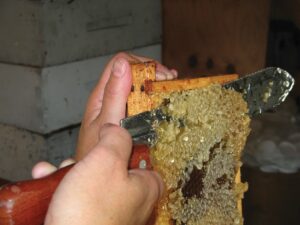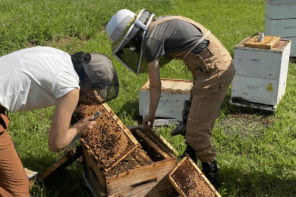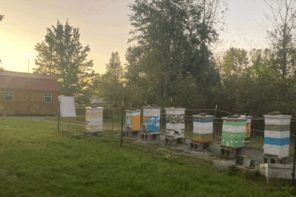Honey Processing
Ross Conrad
When it comes to processing honey, beekeepers have it relatively easy. The bees do the lion’s share of the work.
They gather the nectar, convert the disaccharide sucrose into primarily monosaccharides of glucose and fructose, and drive off the moisture so the water content is below about 18 percent. Honey is the only sweetener we use that can be eaten and enjoyed directly after harvesting. All other sweeteners require significant processing often using energy intensive (and green-house gas producing) methods to render a final product. The only processing honey requires is to make the honey filled combs acceptable for marketing, or to separate the honey from the comb and maybe filter it in order to package the liquid honey for the marketplace.
In the old days, hives were killed off and the harvested honeycomb was squeezed by hand to separate the honey from the wax. While inexpensive, it was a very inefficient and messy job. Today, extracting machines efficiently remove honey using centrifugal force in much the same way that water is forced out of clothing in our washing machines. Removal of honey without destroying the comb allows the bees to reuse the frames of honeycomb, and allows beekeepers to harvest honey without destroying the comb or the hive.
The comb is the furniture, pantry, nursery, and communication aid that makes up the honey bees’ home and represents a substantial investment on the part of the hive in terms of time, labor, and resources. It is estimated that worker bees must consume approximately seven to eight pounds of honey for every single pound of beeswax that they excrete through their wax glands. Aside from sacrificing some of the honey harvest to allow combs to be built, the beekeeper’s investment lies in the cost of acquiring foundation and inserting it into each frame, or repeated timely inspections to ensure foundationless frames are being drawn out straight within the frame and not curved or cross-combed.
Before frames of ripe honey sealed neatly within the comb can be extracted, the wax cappings must first be removed so that the honey contained in each cell can flow out freely. Ways of uncapping frames of honey range from the use of machines that mechanically uncap each frame to manual methods such as the uncapping knife or the capping scratcher (aka uncapping fork). An uncapping knife with a serrated edge is the best way to effectively remove cappings by hand and without heat. The handle of the uncapping knife should be offset and the blade long enough so that each end of the knife will ride along the bottom and top bar of each frame, helping to guide the cut and prevent gouging into the delicate combs. Care must be taken to hold the knife at the appropriate angle so that the blade will not shave off parts of the wooden components of the frame like a wood planer. To increase the ease of the uncapping process, some beekeepers will dip their knife into hot water to heat the blade. Others will invest in an electrically heated uncapping knife. The uncapping fork comes in handy for removing cappings from the areas of comb that the bees do not draw out past the edges of the wooden parts of each frame.
In large operations when extremely high numbers of supers need to be extracted, a large automated electric-powered uncapping machine helps keep one’s wrists from tiring out, although there are smaller, less expensive models designed for backyard and sideline beekeepers.
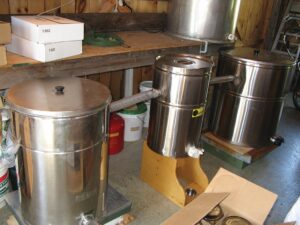
When extracted honey is stored in a settling tank, wax and other hive
components in the honey will float to the top of the tank. By rigging up settling tanks to each other in series so that the clean honey moves up a tube from the bottom of each tank before running over to the next tank, the wax gets left behind and the extracted honey gets progressively cleaner and cleaner. Very little wax will make it to the third tank in this photo, allowing almost all the honey in the final tank to be bottled without the need to use a sieve or filter.
The decision whether to use deep supers, shallow or medium supers to collect and harvest the honey is a personal one that each beekeeper has to make for him- or herself. In terms of strict efficiency, the choice is simple. The deeper the honey super, the more honey it will hold and the faster the honey will be extracted, since it takes about the same amount of time to uncap a shallow frame and run it through an extractor as it does a deep frame especially when uncapping by machine.
On the other hand, the larger the super, the heavier it will be when filled by the bees with the ambrosial gifts of their labor. Today, bee supply companies promote smaller boxes that hold a maximum of eight frames as an alternative for those who wish to save their backs. Whether you choose to utilize eight-frame or ten-frame hive bodies and supers, I strongly recommend that once you have made your choice you stick with one type or the other. Otherwise, the day will inevitably come when you find yourself needing a hive body or super for an eight-frame hive, and the only empty equipment you have available to use is made for ten frames, or vice versa.
Once the honey is removed from the hive and ready for extracting the sooner it is processed the better. There are a lot of problems that can crop up and plague the procrastinating beekeeper that leaves honey supers sitting around. Honey can crystallize, wax worms can get into the combs, or even worse, small hive beetle larvae can ruin the entire honey crop. If stored in a place with high humidity, the moisture content of the honey may rise leading to fermentation.
Once honey extracting commences, variables such as temperature and the types of materials that are allowed to come in contact with the honey become important factors. As with all good production practices, uncapping, extracting, and bottling equipment must be clean and free of foreign materials and debris prior to use. Resist the temptation to get by with cheap plastic or metal materials and equipment. Plastics can leach and off-gas toxic chemicals and many metals will react with honey and can contaminate it. Stainless steel, food-grade plastic, and other food-grade materials must be utilized to reduce the possibility of compromising the harvest’s integrity. In keeping with this train of thought, the temperature that honey is exposed to should not exceed the 95° to 120°F (35° to 49°C) range. This is because all the enzymes in honey are adversely affected at temperatures approaching 120°F, and high temperatures will affect the honey’s color and flavor. This temperature recommendation refers to the temperature range of uncapping and bottling equipment, not room temperature. Room temperatures below 70 may cause the honey to cool and thicken so it does not run out of the combs as readily which slows down the extracting process.
Conventional honey that has been heated will stay liquid on the shelf for a much longer period than unheated honey before crystallizing, and because it is clear, it is typically filtered to remove the tiny particles of pollen, propolis, and beeswax that may have entered the honey during the extraction process. Not only do these minute particles detract from the clarity of the final product, but they also act as nuclei around which crystals may form, speeding up the crystallization process and shortening the shelf life of the liquid honey. Non-filtered honey preserves the nutritional and medicinal benefits that the bits of pollen, beeswax, and propolis impart to the final product. As a result, most natural and organic honey that is available will be unheated and not filtered and therefore crystallized, with the exception being honey that has been freshly harvested and honey from floral sources that naturally resist crystallization, such as Tupelo honey or Sourwood.
While not necessary for taste or storage, honey being prepared for market has the majority of the beeswax, pollen, and propolis removed from the honey. To do this without using heat, a screen or sieve can be used. However, running honey through a sieve can be a slow process, and when harvesting large amounts of honey, settling tanks are the preferred method of making the final product presentable if one is not heating and filtering the honey. As honey sits, miscellaneous hive material that has found its way into the honey will slowly rise to the surface, where it will float. The relatively clear honey at the bottom of the tank can then be drawn off and bottled. This process is slow however, which is why most commercial beekeepers will filter the honey and use a machine that separates the cappings wax from the honey rather than relying on gravity.
No matter how you decide to go about it, processing honey is a sticky job. Just resist the temptation to lick your fingers and not wash them before you stick them back into the honey.
Ross Conrad is the author of Natural Beekeeping: Organic approaches to modern apiculture and co-author of The Land of Milk and Honey: A history of beekeeping in Vermont.






